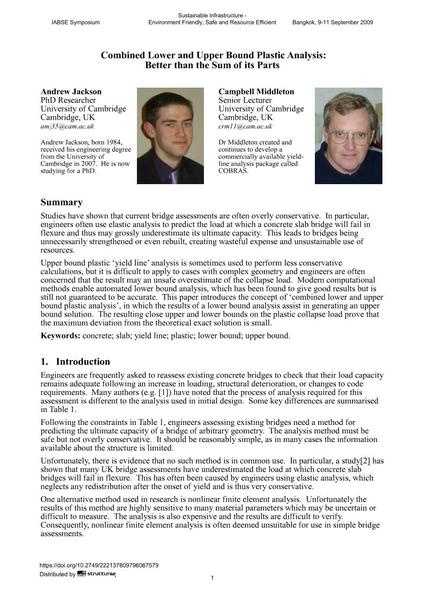Combined Lower and Upper Bound Plastic Analysis: Better than the Sum of its Parts

|
|
|||||||||||
Bibliographic Details
| Author(s): |
Andrew Jackson
Campbell Middleton |
||||
|---|---|---|---|---|---|
| Medium: | conference paper | ||||
| Language(s): | English | ||||
| Conference: | IABSE Symposium: Sustainable Infrastructure - Environment Friendly, Safe and Resource Efficient, Bangkok, Thailand, 9-11 September 2009 | ||||
| Published in: | IABSE Symposium Bangkok 2009 | ||||
|
|||||
| Page(s): | 65-74 | ||||
| Total no. of pages: | 8 | ||||
| Year: | 2009 | ||||
| DOI: | 10.2749/222137809796067579 | ||||
| Abstract: |
Studies have shown that current bridge assessments are often overly conservative. In particular, engineers often use elastic analysis to predict the load at which a concrete slab bridge will fail in flexure and thus may grossly underestimate its ultimate capacity. This leads to bridges being unnecessarily strengthened or even rebuilt, creating wasteful expense and unsustainable use of resources. Upper bound plastic „yield line‟ analysis is sometimes used to perform less conservative calculations, but it is difficult to apply to cases with complex geometry and engineers are often concerned that the result may an unsafe overestimate of the collapse load. Modern computational methods enable automated lower bound analysis, which has been found to give good results but is still not guaranteed to be accurate. This paper introduces the concept of „combined lower and upper bound plastic analysis‟, in which the results of a lower bound analysis assist in generating an upper bound solution. The resulting close upper and lower bounds on the plastic collapse load prove that the maximum deviation from the theoretical exact solution is small. |
||||
| Keywords: |
concrete slab Lower Bound Upper Bound yield line
|
||||
